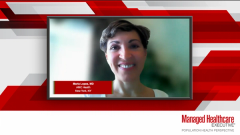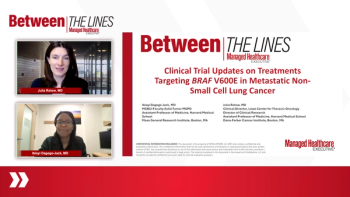
Addressing Unmet Needs in UF
Dr Al-Hendy discusses what it takes to individualize UF treatment for each patient.
Episodes in this series

Ayman Al-Hendy, MD, PhD, FRCSC, FACOG, CCRP: This new medication that I mentioned, elagolix and relugolix, they are formulated with a little bit of estrogen, which can strike a nice balance. But long term, FDA approved them for only 2 years because of that potential concern about long-term negative effects on the bone. They limited the use to 2 years at this point, pending further research. Other options in this area, or other developments, that can be good against the fibroid that's still healthy or good for the bone, would be a great addition. That's another unmet need.
In terms of the recent trials in the field, I've been fortunate to participate in all these trials; fibroid is a focus area for me, both in clinical practice and research. One was the LIBERTY trial, this is a phase 3 clinical program that evaluated the efficacy of oral elagolix against uterine fibroid(s). Another one is the LIBERTY trial, this was a large phase 3 clinical research program to evaluate the effectiveness of relugolix against heaviness of bleeding in patients. In terms of the LIBERTY trial, the FDA always asked for 2 parallel phase 3 trials. These were 2 parallel phase 3 trials, 6 months each, where patients were randomized into 1 of 3 arms. One arm used elagolix alone for 6 months; another arm used elagolix with the add-back therapy, which consisted of 1 milligram of estradiol and half a milligram of norethindrone acetate, which is progesterone, per day; and the third arm was placebo. We treated women with heavy menstrual bleeding, and they were randomized to 1 of the 3 arms. The way we defined heaviness in bleeding in this program was a very objective, lab-based method called [INAUDIBLE]. The patient collected the sanitary pads, and then we sent them to the lab and measured blood loss. To qualify to be in the study, they needed to bleed more than 80 ml per cycle for at least 2 cycles, so 80 ml or higher, that's the definition of heavy menstrual, so all patients had heavy menstruation. We then followed the patient for 6 months by imaging, ultrasound, measuring the amount of bleeding, and a lot of questions about quality of life, etc. Then we compared the 3 arms. The primary manuscript describing the primary results of this trial has been published in the New England Journal in January of 2020, for the audience who wants to have the full details. The results were very encouraging, the response rate was about 75% in the treatment arm with relugolix and add-back therapy, which is the formulation that ended up achieving FDA approval.
The formulation that achieved FDA approval: elagolix 300 milligrams twice a day, with add-back therapy, which is 1 milligram of estradiol and half a milligram of norethindrone acetate. The response rate was 75% in the elagolix add-back therapy arm, versus about 10% in the placebo arm; this was highly statistically significant. We also looked at many other secondary outcomes. I forgot to mention what is considered a response; to be considered a responder, you need to bring your initial blood loss, the heaviness of the blood loss, back to the normal range. The average risk of blood loss in our patients was about 300 ml per cycle, so even though they qualify only about 80, most of our patients had heavy menstruation; obviously it was a range, but on average, there were about 300 ml per cycle. To be considered a responder, you need to bring this back to the normal range under 80, and 75% of the participants achieved that in the treatment arm, versus about 10% in the placebo arm. It's a great response rate. We also looked at other secondary responses; for example, the amount of hemoglobin that the patient managed to add, the correction of anemia, the percent of patients who stopped bleeding altogether, they had amenorrhea, complete cessation of bleeding in the treatment arm versus placebo, etc. The elagolix with add-back therapy achieved statistically significance in all of these secondary outcomes. It was great results from the efficacy point of view.
As far as safety, elagolix with add-back therapy was very well tolerated with very few side effects. The most important to remember, as far as the side effects, more than 5% in the treatment arm had hot flashes, about 20% in the treatment versus around 9% in the placebo arm. Most of these hot flash side effects were mild, single incident per day, and did not lead to the patient discontinuing the trial, which is always a good sign. That's, in summary, the ELARIS program. The LIBERTY program’s design was very similar, so I'm not going to repeat that design. Response was also similar. In the elagolix with the add-back therapy or combination arm, the response rate was about 75%, so about three-quarter of patients met the primary response target after 6 months, versus about 10% in the placebo. Elagolix also achieved most of the other secondary endpoints. A couple of important remarks in terms of LIBERTY program: elagolix has been approved by the FDA, elagolix with the combination therapy, 1 milligram of estradiol and half a milligram of norethindrone acetate as 1 tablet per day. It's a single tablet per day, for up to 2 years. Another important remark unique for the LIBERTY program, we also assess the pain and the effect of the treatment on building pain associated with fibroid, and the results show significant improvement in those in the elagolix arm versus the placebo arm. These results have been published in the New England Journal in 2021, last year, in February 2021.
This transcript has been edited for clarity.
Newsletter
Get the latest industry news, event updates, and more from Managed healthcare Executive.





